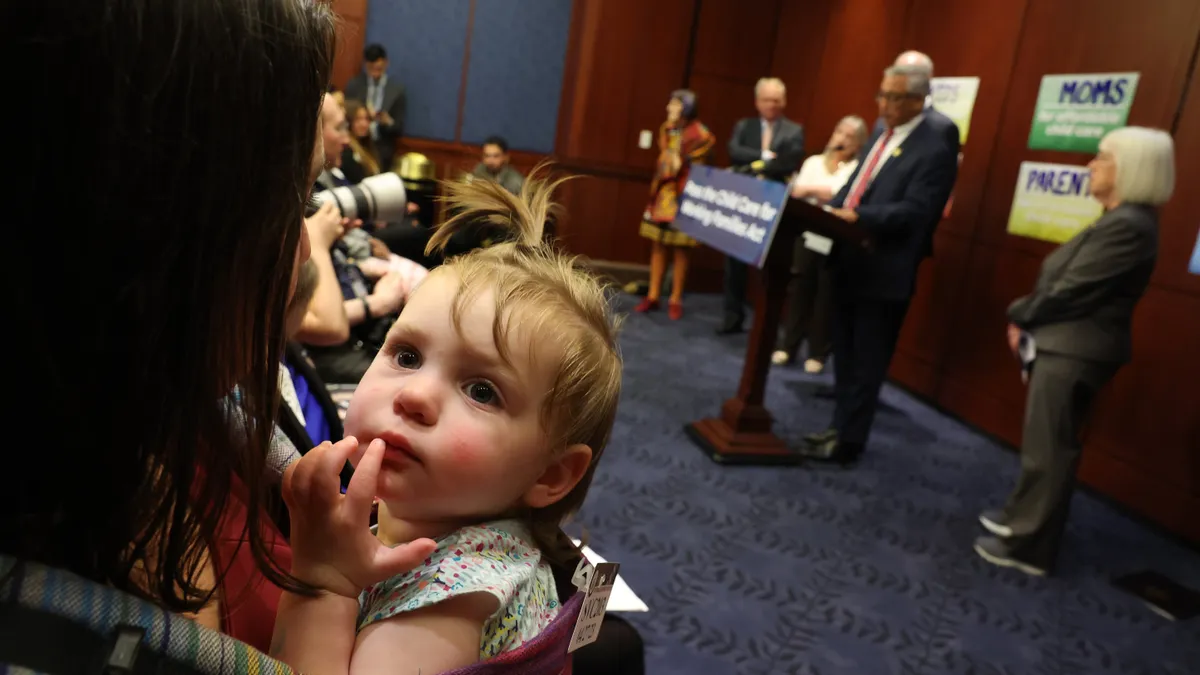NATIONAL HARBOR, Md. — In 2018, leaders at oil and energy services company Halliburton began to think through the company's struggles recruiting women by going to women who already worked in the industry.
As part of a broader diversity strategy, leaders asked those women what problems they faced in the course of their careers, Jennifer Mericle, manager, global benefits at Halliburton, told attendees at the Disability Management Employer Coalition's 2019 annual conference on Tuesday.
"As you can imagine, the most common challenge women face, in general, is trying to decide how and when they want to start a family, and then how to manage a work-life balance so they can be who they want to be both at home and on the job," Mericle said. "I don't think that this is news to anyone. I think it resonates with any company."
But the answer may be particularly insightful for energy companies given the demographic breakdown. According to a 2017 report by Boston Consulting Group and the World Petroleum Council, women make up 22% of the world's oil and gas industry workforce, compared to an average of 38% across all industries measured. Some women cited in a survey included in the report said they were concerned that their use of benefits like parental leave would be perceived differently than if a man had used the same benefits.
Prior to Halliburton's decision to revisit its parental leave program, the company offered an eight-week paid paternity leave benefit. It made changes when it rolled out the Halliburton Family Care Program in the summer of 2018, extending the existing paternity leave benefit to eight weeks of paid bonding leave for mothers and fathers beginning either on the date of birth or the date an adoption is finalized.
Employees also now have the option to take the equivalent of a two-week pay out, which might be attractive to staff who would lose out on overtime bonuses (the paid leave benefit is paid out as straight time).
"We knew that we wanted to move quickly," Mericle said, noting that Halliburton's broker, ReedGroup, helped it identify emerging leave requirements in the states. "We knew we kind of wanted to take the Cadillac of whatever the new state leaves were coming out and try to use that as the model we wanted to work with."
From the beginning, Halliburton had big expectations for the program, Mericle said. "We really wanted this to be more than a program, we wanted this to be a culture change for us. This type of leave — taking time off to be with your family — was really not part of our culture."
Not everyone jumped on board initially, though, despite buy-in from executives. Mericle said operations leaders were concerned about workers taking leave at the same time, particularly during busy periods. Her team took the feedback in stride, adding steps including a provision that managers had to sign off on paid bonding leave, and that there would need to be a commitment on both sides to ensure the leave would benefit the business as well as employees.
There are other restrictions on the leave, too. Halliburton requires that employees take bonding leave within twelve months of the adoption finalization or birth date, and the company also implements "black-out dates" to prevent negative impact on business during key holiday times.
Mericle explained that part of the business case made to leaders included costs incurred from attrition and onboarding, particularly with its field positions. "There's a lot that goes into bringing these people on," she said. "The analysis was done to kind of weigh the cost of paying someone eight extra weeks of pay versus what we're losing every time we lost someone and have to start over."
That estimate relied on actual data on turnover in addition to feedback from exit interviews that indicated why employees were leaving, Mericle said.
"Communication was definitely the most important aspect of the change management," Mericle said. Halliburton sent an email and postcard to all employees in addition to business practice publications, FAQs and training documents. "We spent a lot of time listening to operations from the beginning."
Mericle added that part of ensuring inclusivity was making sure the company could roll out something that benefited the entire workforce: "We wanted a benefit that was available to all employees and not just the female employees." Halliburton initially expected a large amount of employees would take the two-week pay-out option instead of eight weeks' paid bonding, but that's not exactly how things turned out.
"We actually kind of had an overall utilization with an 80-20 split and paid leave being the more popular choice," Mericle said. "It was really wonderful to see so many fathers who were taking the time to engage and be an integral part of their family bonding experience."
But there's still a lot of research to do on the benefit's actual impact on the company's recruitment goals, she noted. Anecdotal feedback has been positive, but Halliburton is still gathering data on attrition, retention and other metrics.
Implementation doesn't mean the work on the benefit is done, either. Mericle said the company is also considering benefits for those who opt to provide foster care, and she noted that company has had discussions about how it might change its existing policy on adoption leave to better suit the needs of those going through the adoption process.
The use of parental leave and bonding leave as a recruiting tool has trended upward in recent years, according to data from Mercer — and with various states making paid leave laws, that trend will likely continue.



















